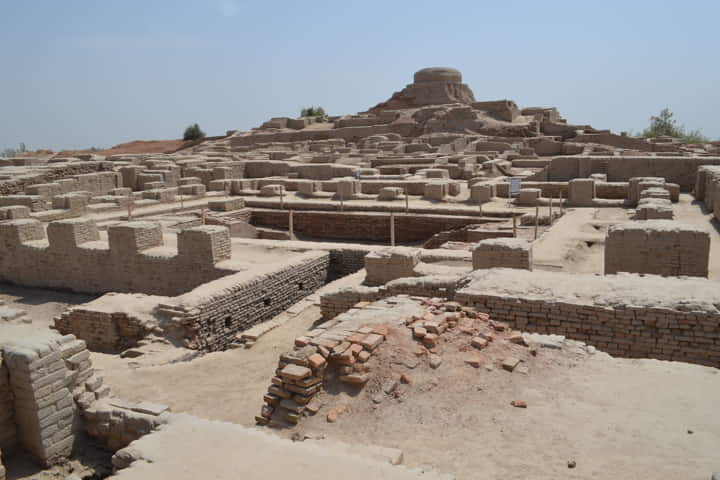

A recent study links suggest links between Dravidians and the ancient Indus Valley Civilisation
<p>
<strong>For any civilisation, language is of prime importance. As a medium of communication and exchange of ideas, it contributes to the advancement of the people and their culture and thus historians have always zoomed in on it while studying ancient civilisations.</strong></p>
<p>
A recent study on languages has been published in the peer-reviewed journal of the Springer Nature Group. It is titled &lsquo;Ancestral Dravidian languages in Indus Civilization: ultraconserved Dravidian tooth-word reveals deep linguistic ancestry and supports genetics&rsquo;.</p>
<p>
The study has been penned by software developer and independent researcher Bahata Ansumali Mukhopadhyay. It tries to prove the link between Dravidians and the ancient Indus Valley Civilisation &ndash; the oldest in the subcontinent. It suggests that a large number of inhabitants of the Indus Valley conversed in ancestral Dravidian languages.</p>
<p>
<strong>Also read: <a href="https://www.indianarrative.com/culture-news/ancient-artefacts-belonging-to-th-century-ad-found-under-garbage-pile-107611.html">Ancient artefacts belonging to 9th Century AD found under garbage pile</a></strong></p>
<p>
Taking into account the prosperous trade links between IVC and the Persian Gulf and Mesopotamia, Mukhopadhyay looked through texts of the near-Eastern region to find out foreign words which have roots in the Indus Valley.</p>
<p>
The logic for this, as mentioned in the study, states that a commodity which is not produced locally is referred to by its foreign name.</p>
<p>
With this framework in place it was found by the study that in the language &ndash; Akkadian &ndash; spoken by ancient Mesopotamia the word denoting elephant — &lsquo;p&#299;ru&rsquo;/&lsquo;p&#299;ri&rsquo; and their variations, and also the old Persian word for ivory, &lsquo;p&#299;rus&rsquo; are possibly rooted in the Indus Valley.</p>
<p>
In his paper, Mukhopadhyay wrote: &ldquo;My study argues that since archaeological data strongly associates Near Eastern ivory-objects of middle-third to early-second millennium BC with Asian elephants and IVC traders , and since the ivory-words (e.g., &lsquo;ab&rsquo;, &lsquo;abu&rsquo;, &lsquo;&#551;b&rsquo;, &lsquo;be&#7717;u&rsquo;, &lsquo;netche&#7717;-t&rsquo;) used in ancient Egypt (the only other major source of prehistoric ivory), has no phonetic connection to &lsquo;p&#299;ru&rsquo;, these &lsquo;p&#299;ru&rsquo;-based words could likely have originated in IVC.&rdquo;</p>
<p>
In the paper it is also suggested that words &lsquo;p&#299;lu&rsquo;, &lsquo;pella&rsquo;, &lsquo;palla&rsquo;, &lsquo;pallava&rsquo;, &lsquo;pi&#7735;&#7735;uvam&rsquo;, &lsquo;p&#299;luru&rsquo; in several Dravidian languages are used to denote elephant.</p>
<p>
<strong>Also read: <a href="https://www.indianarrative.com/culture-news/a-old-year-babylonian-clay-tablet-shows-masterly-use-of-applied-geometry-106252.html">A 3,700-year-old Babylonian clay tablet shows masterly use of Applied Geometry!</a></strong></p>
<p>
On the point of discrepancy between the use of the letter &lsquo;l&rsquo; in the Indic languages and &lsquo;r&rsquo; in Akkadian and old Persian, Mukhopadhyay said: &ldquo;Since people of ancient Persia had functioned as intermediaries between Mesopotamia and IVC traders, while exporting IVC&rsquo;s ivory, they had arguably spread the Indic elephant word (&lsquo;piru&rsquo; &lsquo;pilu&rsquo;) to Mesopotamia as well.&rdquo;</p>
<p>
Another piece of evidence too is given by the paper as it connects &lsquo;pilu&rsquo; with the words used for tooth in proto-Dravidian. Many Indic words refer to &lsquo;Salvadora persica&rsquo; as &lsquo;pilu&rsquo; thereby suggesting that like pilu — the elephant word, the name used for the tree too is rooted in the proto-Dravidian word for tooth.</p>
<p>
&lsquo;Salvadora persica&rsquo; is popularly known as the toothbrush tree in the West while in the Arabic speaking nations it is &lsquo;Miswak&rsquo;.&rsquo;</p>
India and China are making significant strides in their bilateral relations, with constructive engagements taking…
The Ministry of External Affairs (MEA) on Thursday said it has no update on the…
The First General Assembly of the Indian Himalayan Council of Nalanda Buddhist Tradition (IHCNBT) was…
Representative Thinlay Chukki of the Tibet Bureau Geneva attended a side event on the situation…
India has achieved a historic milestone by surpassing 1 billion tonnes in coal production, marking…
A federal judge has blocked Donald Trump's administration's move to deport a Georgetown University researcher…